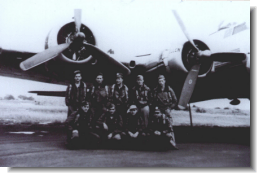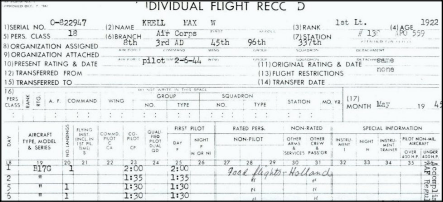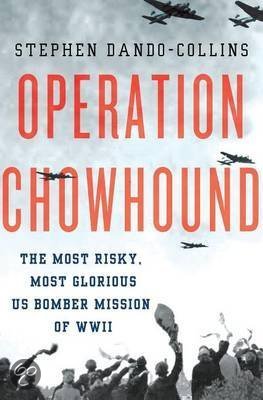Max Krell
It's early in the morning on May 1. Max and the other guys in one of the metal Quonset hut at Snetterton Heath airbase are fast asleep. They have been issued a sign last night that there will be another mission today, but there are some doubts that they will be flying today. In the past ten days they have had several calls, but after their last mission on Carlsbad, Czechoslovakia all those missions have been scrubbed. The men know about the plight of the Dutch and that they are scheduled to drop food for them. The weather has ruined the previous missions and again it doesn't look good.
 Then the orderly comes in with his flashlight, and he wakes the men that are scheduled for today's mission. While Max rises from his cot and hurries in his clothes he is still wondering if they will really fly a mission today or if this is another last minute cancel. He shaves, as he had done for every mission. It is necessary so he can comfortably wear the oxygen mask for several hours in a row. This time they will have a short low-level mission, not another Czechoslovakia or Berlin.
Then the orderly comes in with his flashlight, and he wakes the men that are scheduled for today's mission. While Max rises from his cot and hurries in his clothes he is still wondering if they will really fly a mission today or if this is another last minute cancel. He shaves, as he had done for every mission. It is necessary so he can comfortably wear the oxygen mask for several hours in a row. This time they will have a short low-level mission, not another Czechoslovakia or Berlin.
When Max has finished his routine he hurries to the dinning hall. There he teams up with Walter, George and Adrian, the other officers in his crew. They discuss their thoughts and speculations on the upcoming mission over a hot breakfast.
After dinner they walk to the flight line for briefing. They find Lloyd the crew's radio operator there while George is off to the navigator's briefing.
Major Wilson the operations officer walkes in and they do their time check. The curtain is removed and the men can see the red line crawl towards Holland. They learn that ten-in-one rations are stacked on wooden floors, which have been installed in the bombers in the past days. They have already noticed that it is still very cloudy outside. Major Wilson assures the men that the sky is clear over Holland and because of the great importance of the mission they have decided to push the mission through.
All they learn about the Dutch is that the part of Holland where they will drop the food is still under occupation of the Germans and that the shortage of food is increasing daily. The target of the day is an airfield called Ypenburg, which is located near The Hague.
Major Wilson tells Max and the other officers about the truce that has been signed with the Germans. What he doesn't tell them is that he himself is not at all sure if the Germans will indeed stick to the truce. To insure that the truce is kept, the bomb group headquarters have decided that Major Godecke will fly with his two wingmen over the drop zone before the other bombers and if he is not shot at he will radio a green light signal to the other bombers who will be over the Channel at that time.
The men are brought to their bombers after the meeting. They find Timothy, Floyd, Frank, Thomas and Prior busy installing their guns. Everybody agrees on the fact that it is wise to bring all the gunners. You can't take any chances with these Germans.
When all are aboard they wait for the exact time to start the engines. Then within a few minutes 124 engines start roaring. Forty-one bombers line up. The green light appears and all the pilots move into position to take off.
It is rainy and cloudy today, but within a few minutes all the bombers are airborne. Getting in position at 1500 feet proofs to be a much more difficult than getting the formation lined up in the clear sky above the clouds at 10.000 or 12.000 feet. This time the mission will be carried out entirely at low level.
The group crossed the coast at 1500 feet and Max remembers seeing the German soldiers at the antiaircraft guns looking up at them. They seemed close enough to throw rocks at them.
The airfield was located without difficulty and the drop made from 400 feet. The wheels and flaps had to be lowered and the power settings were changed to cut back the speed to 130 mph.
The floors that have been installed in the bomb-bays hang on the outer edges and rest on the inside on the bombshackes which are located in the middle of the bomb-bay next to the middle catwalk. The wooden floors tumble and the rations are released over the dropzone. The crew pull the floors back in the bomb-bay by hand so that the bay-doors can be closed again.
In the meanwhile several of the crewmembers are able to see the whole show that is going down below them. Max recalls: "Such signs of celebration we had never seen before nor since as the people hurried to retrieve their food from the sky. People waved at the planes, flags where everywhere and we had no doubt that the effort had been appreciated. Because of the unwieldy nature of the load, some packaged didn't drop cleanly and had to be kicked out of the bomb bay by our crew. Each package seemed to have a recipient soon after it hit the ground, no matter where it landed. A few were even observed being recovered from canals. When we had safely returned from our mission after a good four-hour flight, one story made rounds that one dropping food package had flattened a cow in a pasture field."

"After hauling bombs and being shot at by enemy fighters and antiaircraft fire it was a great experience to see so many people being happy because we could bring them something to eat."
